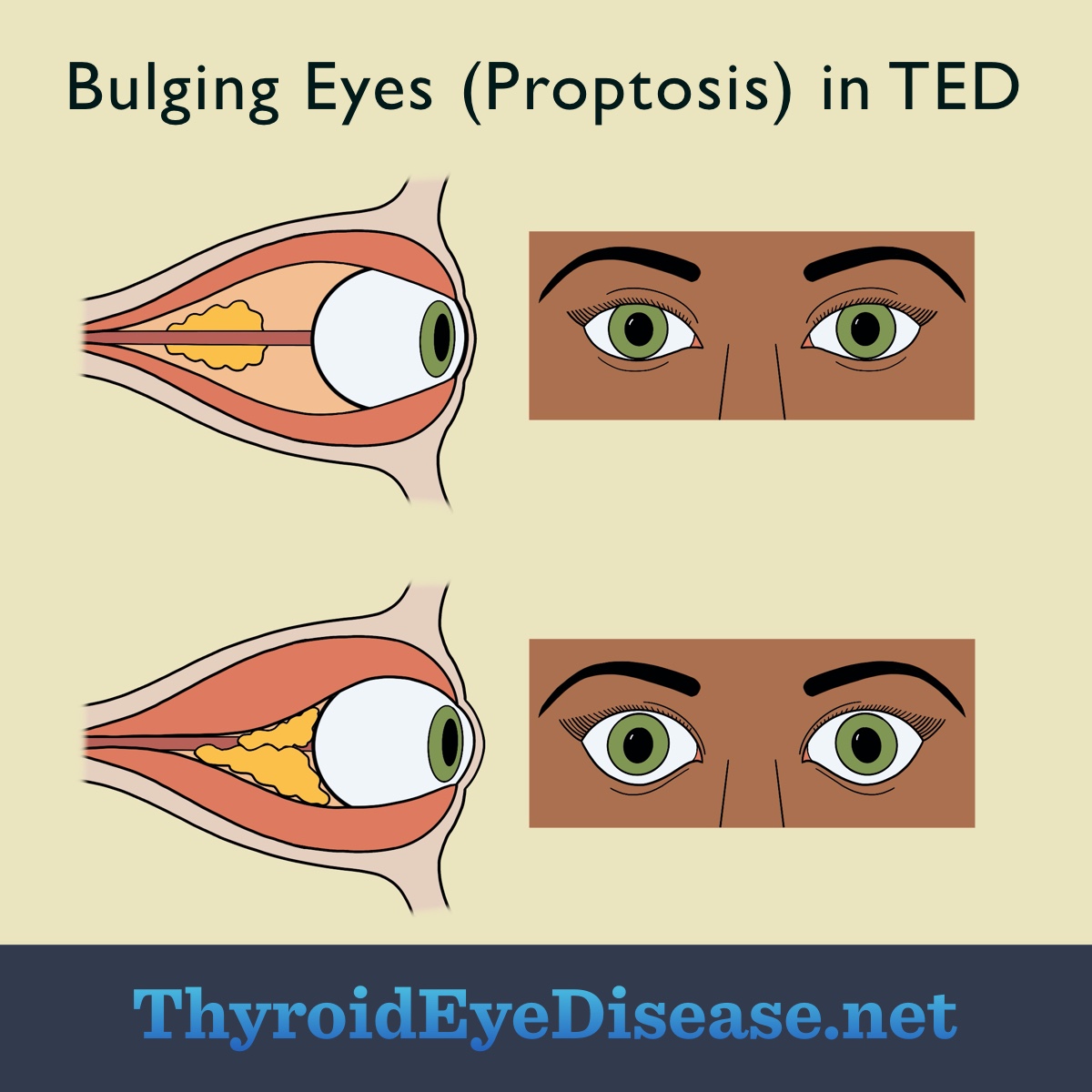Bulging Eyes (Proptosis)
Reviewed by: HU Medical Review Board | Last reviewed: October 2021 | Last updated: May 2025
Even though thyroid eye disease (TED) affects the eyes, some symptoms of TED may not be easily seen by those without the condition. However, some signs of TED are visible. This can be physically and emotionally challenging to deal with because of their impact on your appearance, self-confidence, and general well-being.
Swelling behind the eyes from TED can lead to a stare-like glance, which can look like your eyes are bulging. Known as proptosis (prop-toe-sis) or exophthalmos (ek-sof-thal-miss), this symptom can have a deep impact on your physical and emotional health.1
Proptosis and TED
Thyroid eye disease is an autoimmune disease. Autoimmune means that the body mistakes healthy tissue for harmful invaders such as germs. When the body makes this mistake, the immune system attacks healthy tissue. In TED, the body’s immune system attacks healthy tissue around the eyes. This leads to the classic symptoms of TED, including:1
- Swelling behind the eye and around the eye and eyelid
- Pain or pressure in and around the eye
- Irritation or gritty feeling on the surface of the eye
- Vision changes, such as double or blurred vision
Fat deposits behind the eye help protect the eye from the bony socket, where the eyeball sits. However, TED causes this fat to swell, which can physically push the eye forward out of the socket. This leads to the classic stare-like glance and bulging eyes. Protruding eyes impacts 6 out of 10 people with TED.1-3
Problems caused by bulging eyes
Your face and eyes are usually the first things others notice about you. When you have a visible symptom like proptosis, this can lead to feelings of insecurity, self-consciousness, and social isolation. Even if you are the only person who notices these changes, they can deeply impact your life.4
Beyond the cosmetic issues, proptosis can lead to physical discomfort and complications, including:1-3
- Dry eyes – When the eye is pushed out of the socket, more of the eyeball is exposed to the air. Plus, it is harder for the eyelids to cover the eyes when blinking. Because blinking is protective and restorative to the eye, problems with blinking can lead to dry eyes.
- Corneal ulcer – An open sore on the front of the eye is known as a corneal ulcer. Impaired blinking and dry eye that occurs in TED increases the risk of this complication.
- Eye pain and pressure – Dry, irritated eyes, along with the physical force of fat swelling behind the eye, leads to eye discomfort.
- Vision changes and problems with the optic nerve – The optic nerve is a communication highway from the eye to your brain. When fat and other tissues swell behind and around the eye, the optic nerve can be affected. This leads to vision problems. While these vision problems are often mild, compression of the optic nerve can lead to vision loss if not promptly treated.
Diagnosis
When you are referred to a TED specialist, they will perform various tests to confirm and diagnose the severity of proptosis. Along with a full eye exam, your doctor will use other tests, including:
Eye measurements
Your TED specialist will measure the amount of eye-bulging with a special ruler called an exophthalmometer (ek-sof-thul-mom-i-ter). There are different types of these devices, but they are all used to measure the amount of protrusion of the eye.3
Your doctor will also measure the pressure inside your eye using a procedure called tonometry. After putting numbing drops in your eyes, the doctor will use a blue light device to gently touch the surface of your eye. This device applies a small amount of pressure, allowing your doctor to measure the exact amount of pressure inside each eye.3,5
Diagnostic imaging
Computed tomography (CT) and magnetic resonance imaging (MRI) are advanced imaging tests used to help diagnose and assess the severity of proptosis. MRI provides the best way to see the inflammatory changes that occur in TED.6,7
Treatment
There are treatment options for protruding eyes caused by TED. Some options include:8,9
- Steroids, which are usually the first-line drug for treating proptosis. Steroids work to rapidly decrease inflammation caused by TED. However, long-term use of steroids have side effects, and some people are not able to take them.
- Disease-modifying drugs, which work to decrease symptoms by acting like the proteins made by your immune system. In 2021, the U.S. Food and Drug Administration (FDA) approved the first disease-modifying drug to treat TED. TepezzaⓇ (teprotumumab) works by blocking a receptor in the body that helps to decrease symptoms related to TED.
- Orbital decompression surgery, which is a surgical procedure performed by the TED specialist. This procedure opens up the eye socket to make room for the swollen tissues and fat behind the eye, relieving pressure. Orbital decompression is performed in the inactive phase of TED, when inflammation has slowed or stopped.
Because TED is a chronic (long-term) condition that gets worse over time, it is important to see a TED specialist as soon as possible to avoid further complications. These specialized eye doctors can diagnose and treat the symptoms related to TED, ensuring you get the care you need.
